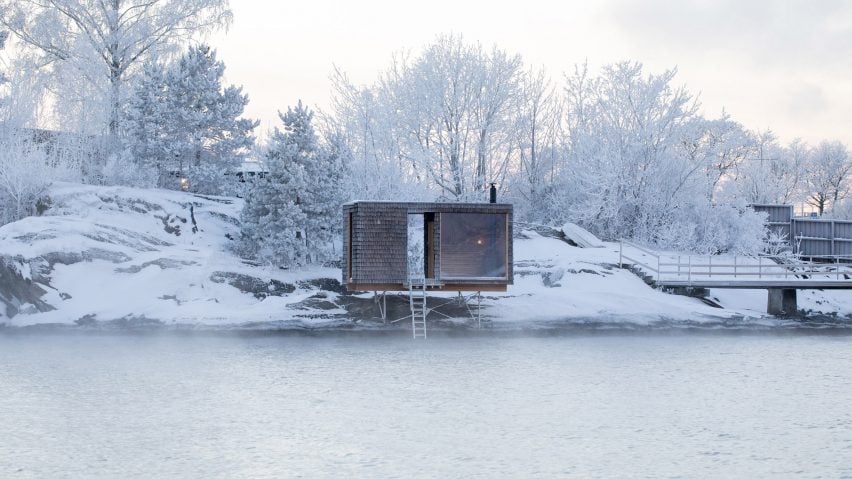Wooden shingles cloak this stilted sauna, which architecture studio Oslo Works has elevated over the rocky shore of Nesodden peninsula, Norway, for the local community.
Named The Hotspot, the wooden structure is a short ferry ride from the Norwegian capital Oslo and is designed to be adaptable, environmentally conscious and low maintenance.
It is the latest addition to the growing number of communal saunas in the region, which Oslo Works said are typically created by local communities coming together to finance and build them.
"A sauna is best enjoyed together," said the studio.
"This may be the reason why sauna community culture has been rising in Scandinavia the last few years. People are putting their forces together in order to finance, build and share hothouse all along the shore."
The Hotspot is divided into two parts by a narrow open passage, which leads to the water and the bathing ladder. The main hot room sits to the left while changing and storage facilities are on the right.
Visitors are encouraged to take a plunge into the icy waters before gathering in the hot room, which is heated by a small woodburning stove and has "breathtaking views" of Oslo's skyline from its panoramic window.
Retaining focus on these views was prioritised throughout the design, with Oslo Works developing a material palette that helps the structure to camouflage with its surroundings when viewed from inland.
The main room features a rounded back wall covered in burnt and oiled pine shingles, enabling the cabin to blend in "among the pine trees and grey granite shore rocks", the studio said.
Wood has also been used for the structure, with large timber modules forming its frame. This was chosen to help minimise the embodied carbon of the project.
A naturally dense insulation material, the wood also efficiently stores the heat inside the cabin, while regulating the moisture generated from the sauna.
"The massive wood elements store heat very well," Oslo Works told Dezeen.
"They isolate it from the cold without the use of insulation material," it continued. "By using only massive wood elements and burnt shingles, the cabin also needs very little maintenance."
The Hotspot's modular structure enabled the sauna to be easily transported to and constructed on the difficult-to-access site, where it now sits raised on metal stilts.
Its modularity also ensures future flexibility, with potential adaptations including the addition of a roof terrace, additional shower rooms and the possibility of being connected to other "Hotspots" in a row.
"We hope that [the community] and other clients will want to use our design to set up even more saunas in the future," said Oslo Works.
"The modular design is flexible and versatile for different needs and locations."
The popularity of communal saunas in Scandinavia can be traced through the region's rich bathing history. Not constrained to isolated natural landscapes, public saunas have been installed at the heart of dense cities, including in Tampere, Finland, where Studio Puisto designed one as a "communal living room".
In Sweden, Raumlabor's corrugated steel public sauna overlooks Gothenburg's Port, defying traditional timber sauna designs to fit into this industrial landscape.
The photography is by Marte Garmann.

